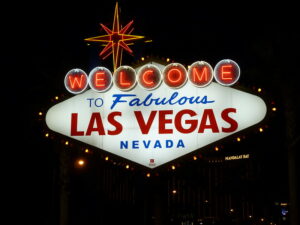Formula One’s circus in Las Vegas
Formula One’s relaunch of a Grand Prix in Las Vegas was, for all its pageantry, simultaneously a roaring success and a spectacular failure.

Given the levels hype around the event, it would have been near-impossible for it to have disappointed in the same way as its predecessor from the early 1980s – the Caesars Palace Grand Prix.
It is no secret that F1’s primary objective is to make money. Be it through encouraging new fans with exciting on-track action or marketing drivers as mega-celebrities – whichever pays the most.
Racing was always intended as a by-product of this Grand Prix – Las Vegas was supposed to be a show, getting as many eyes as possible on the sport.
World champion Max Verstappen was critical of this, saying in a press conference: “When I was a kid it was about the emotion of the sport, and not the show. As a real racer that shouldn’t really matter.
“Most of them [fans] just come to have a party. I can go to Ibiza and get completely sh*t-faced and have a good time.
“I love Vegas, but not to drive an F1 car. [The] emotion and passion is not there compared to some old school tracks.”
Max Verstappen took over 2 minutes to fully explain his issues with the Las Vegas GP and it really shows how much he lives & breathes motorsports.
Every fan and F1/Liberty Media executive should watch this. Everything he said is 100% correct. pic.twitter.com/cchI663AaC
— Dan’s DRS Zone (@F1GuyDan) November 18, 2023
Tragedy struck the event early on when a construction worker was killed after being injured setting up the grandstand outside the Bellagio hotel.
It is important to recognise that this tragic event was not a result of the calamitous occasion itself. Rather it was a horrific accident that ended up setting a mellow tone for the remainder of the weekend.
When even residents of Sin City are complaining about the greed of F1, it becomes clear the scale on which the sport attempted to take over Las Vegas.
Restaurants were charged for the privilege of existing trackside, roads were closed, and most egregious of all – the views from temporary walkways were blocked off to prevent pedestrians from getting a glimpse of the track without coughing up the extortionate price of a race ticket.
Fans at the Las Vegas Grand Prix tore down view-blocking screens along the Strip, expressing dissatisfaction with the controversial track-blocking measures.
The race faced prior controversy as view-blocking filters on pedestrian bridges were applied, limiting access for those… pic.twitter.com/zPrI14KLNW
— Fastest Pitstop (@FastestPitStop) November 19, 2023
Even with the massive disruption to the city, the track was not fit for racing come the first practice session on Thursday night.
A loose drain cover destroyed Carlos Sainz’s Ferrari, calling an end to the session after less than ten minutes. This is not the first time that a drain cover has caused issues in F1 – George Russell found himself the victim of one in Baku in 2019.
Despite the fault of this incident being clearly on F1 and the track developers, Sainz was slapped with a ten-place grid penalty to replace his destroyed power unit – despite Ferrari’s best efforts to be granted an exception.
The second session was delayed until 2:30am, sending ticket-wielding fans away out of pocket. A class action lawsuit has been launched on the behalf of the fans, who were offered just $200 vouchers to spend on merchandise as compensation.
To top this off, with F1 the sole attraction, the track was ‘green’. An unraced track offers drivers significantly less grip – Since cars had not yet laid rubber onto the track, drivers struggled to keep control of their vehicles.
Sainz and Aston Martin’s Fernando Alonso both spun on the first corner as a result, while McLaren’s Lando Norris was left hospitalised after his lap three crash.
Formula 2 should have held its season finale here. With 82 days between their penultimate race and its closer in Abu Dhabi, it seems logical that they should have brought the feeder series to the lights of Vegas, and rubber-in the track with it.
It was not a good start to the weekend, despite Mercedes boss Toto Wolff refuting claims Vegas had given F1 a “black eye”.
In complete fairness, the on-track action was great – Vegas now being the race with the second most overtakes of the season.
There were 82 separate overtakes during the Las Vegas Grand Prix, ranking it #2 in the 2023 season overall behind Zandvoort! 💨
(h/t @virtualstatman) pic.twitter.com/ew3Wyf1402
— ESPN F1 (@ESPNF1) November 19, 2023
Despite what racing purists may say, F1 has always been a show, the spectacle of Vegas can fit perfectly with the sport – there is a reason that the sport has chased the dream of driving down the Strip for so long.
With three US races, questions over Miami’s place on the calendar have been raised.
Miami doesn’t have a place on the calendar to me anymore
With Austin and Vegas we have a traditional circuit + street track, we have very different cultures and settings which represents the diverse US and we have the ‘show’ element 🇺🇸
What does Miami now offer that’s unique?
— Aldas🇱🇹 (@Aldas001) November 19, 2023
In an ideal world, F1 would drop to two US races, keeping the Circuit of the Americas in Austin, Texas, and rotating between Las Vegas and Miami.
This would open a slot in the calendar that could be filled by either a return to Germany or an African Grand Prix.
However, with Miami locked in until 2031 and Vegas unofficially until 2032, it seems Austin will unfortunately be the first to budge, with its contract ending in 2026.
The Las Vegas circus is not stopping anytime soon. It is down to F1 organisers to make sure that future races learn from 2023 and make next year everything it could be.